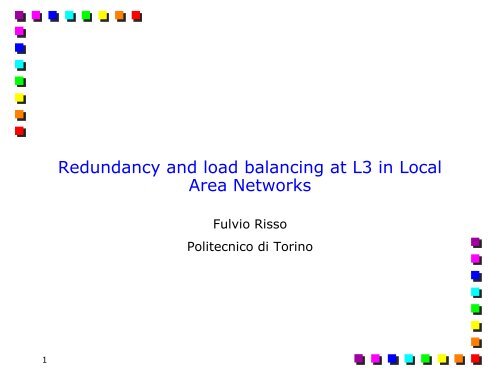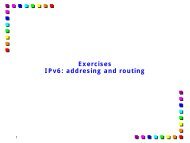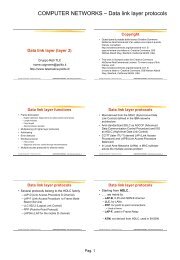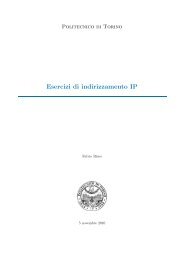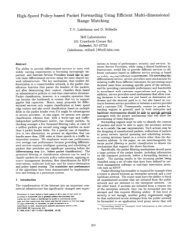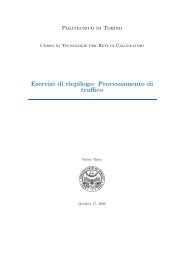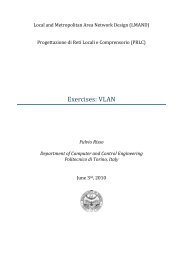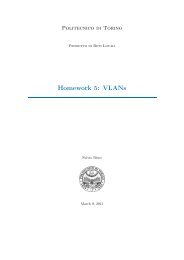L3 redundancy.pdf - the Netgroup at Politecnico di Torino
L3 redundancy.pdf - the Netgroup at Politecnico di Torino
L3 redundancy.pdf - the Netgroup at Politecnico di Torino
You also want an ePaper? Increase the reach of your titles
YUMPU automatically turns print PDFs into web optimized ePapers that Google loves.
Redundancy and load balancing <strong>at</strong> <strong>L3</strong> in LocalArea NetworksFulvio Risso<strong>Politecnico</strong> <strong>di</strong> <strong>Torino</strong>1
Default g<strong>at</strong>eway <strong>redundancy</strong> (1)H1DG: R1H2DG: R1H3DG: R1R1R2ISP1ISP2Internet3
Default g<strong>at</strong>eway <strong>redundancy</strong> (2)• Objective• Provide <strong>redundancy</strong> of <strong>the</strong> default g<strong>at</strong>eway• Two routers on <strong>the</strong> LAN are useless if hosts are not able toswitch to ano<strong>the</strong>r one in case <strong>the</strong> first fails• Hosts on <strong>the</strong> LAN are not able to learn <strong>the</strong> network topologythrough Layer 3 routing protocols• Please note th<strong>at</strong> incoming traffic (from <strong>the</strong> Internet to <strong>the</strong>LAN) will arrive correctly, even if one router fails• We are having troubles only in <strong>the</strong> opposite <strong>di</strong>rection4
Default g<strong>at</strong>eway <strong>redundancy</strong> (3)• Solutions• HSRP (Hot Standby Routing Protocol)• Cisco proprietary protocol defined in RFC 2281• VRRP (Virtual Router Redundancy Protocol)• Standard protocol defined in RFC 3768• GLBP (G<strong>at</strong>eway Load Balancing Protocol)• Cisco proprietary protocol5
昨 年 開 催 の 様 子© 吉 田 太 郎* 写 真 素 材 のご 用 意 がございます。 下 記 、 広 報 事 務 局 までお 問 い 合 わせください。ランドマークプラザ 広 報 事 務 局 担 当 : 石 田 / 濱 TEL.03-3479-3873 FAX.03-3403-0359メールアドレス:plaza-pr@ozma.co.jp※ 広 報 事 務 局 の FAX 番 号 とメールアドレスが 変 更 になりました。ランドマークプラザ TEL.:045-222-5015URL:http://www.yokohama-landmark.jp/
HSRP: <strong>the</strong> ideaH1DG: 2.2.2.4H2DG: 2.2.2.4H3DG: 2.2.2.4ARP Request: who hasIP 2.2.2.4?ARP Reply: IP 2.2.2.4 is <strong>at</strong>MAC 00:00:00:44:44:44“Hello” packetsR3 (active)IP: 2.2.2.3MAC: 00:00:00:33:33:33HSRP Group: 4Virtual IP: 2.2.2.4Virtual MAC: 00:00:00:44:44:44R2 (stand-by)IP: 2.2.2.2MAC: 00:00:0:22:22:22R1 (listen)IP: 2.2.2.1MAC: 00:00:00:11:11:11HSRP Group: 4Internet7
HSRP: working oper<strong>at</strong>ions (1)• Routers th<strong>at</strong> provide <strong>redundancy</strong> belong to <strong>the</strong> same “group”• Each group emul<strong>at</strong>es a single virtual router• Routers can be• Active: <strong>the</strong> one th<strong>at</strong> has <strong>the</strong> right to serve <strong>the</strong> LAN• Stand-by: <strong>the</strong> one th<strong>at</strong> takes place in case <strong>the</strong> Active fails• Listen: <strong>the</strong> o<strong>the</strong>rs th<strong>at</strong> are nei<strong>the</strong>r Active nor Stand-by• May become stand-by in case <strong>the</strong> active fails• Within each group, we define two ad<strong>di</strong>tional (shared)addresses• A virtual IP address• A virtual MAC address8
HSRP: working oper<strong>at</strong>ions (2)• The interface of <strong>the</strong> Active router has <strong>the</strong> followings assignedaddresses:• Primary IP address (inserted in <strong>the</strong> source IP header field)• Virtual IP address (used by hosts as default g<strong>at</strong>eway)• Physical MAC address assigned by <strong>the</strong> NIC manufacturer• Virtual MAC address alloc<strong>at</strong>ed to <strong>the</strong> HSRP Group• Well-known MAC address, derived by <strong>the</strong> HSRP group• The interfaces of <strong>the</strong> Standby and Listen routers have <strong>the</strong>followings assigned addresses:• Primary IP address (inserted in <strong>the</strong> source IP header field)• Physical MAC address assigned by <strong>the</strong> NIC manufacturer9
HSRP: working oper<strong>at</strong>ions (4)• Keep-alive message• Used to elect <strong>the</strong> router current in “active” mode• Priority• (or, if equal) Higher IP address11
HSRP packet form<strong>at</strong>MACheaderIP headerUDPheaderHSRPFCS0 8 16 24 31Version Op Code St<strong>at</strong>e Hello-timeHold-time Priority Group ReservedAu<strong>the</strong>ntic<strong>at</strong>ion D<strong>at</strong>aAu<strong>the</strong>ntic<strong>at</strong>ion D<strong>at</strong>aVirtual IP Address13
HSRP Encapsul<strong>at</strong>ion• HSRP packets• Required for <strong>the</strong> “keepalive” function between routers• Encapsul<strong>at</strong>ed in UDP, src/dst port is 1985• IP Layer• Transmitted to multicast address 224.0.0.2 (“all routers”)• Source IP address is <strong>the</strong> actual IP address of <strong>the</strong> router (in orderto elect <strong>the</strong> best router as active)• TTL = 1 (packets are not fur<strong>the</strong>r forwarded by routers)• MAC layer• Destin<strong>at</strong>ion address: derived from <strong>the</strong> Destin<strong>at</strong>ion IP address• Source MAC: Virtual MAC address for <strong>the</strong> group14
HSRP header: “opcode” field• Describes <strong>the</strong> type of message contained in this packet• Possible values• 0 = Hello• The router is running and is capable of becoming <strong>the</strong> active orstandby router• 1 = Coup• The router wants to become <strong>the</strong> active router• 2 = Resign• The router does no longer want to be <strong>the</strong> active router• “Coup” and “Resign” are not necessarily used toge<strong>the</strong>r• E.g. a router th<strong>at</strong> has highest priority can send <strong>the</strong> “coup” message totake over <strong>the</strong> current router, but this router goes into “speak” st<strong>at</strong>ewithout sen<strong>di</strong>ng any “resign”15
HSRP header: “st<strong>at</strong>e” field (1)• Describes <strong>the</strong> current st<strong>at</strong>e of <strong>the</strong> router sen<strong>di</strong>ng <strong>the</strong>message• Possible values• 0 = Initial• This is <strong>the</strong> starting st<strong>at</strong>e and in<strong>di</strong>c<strong>at</strong>es th<strong>at</strong> HSRP is not running• 1 = Learn• The router has not determined <strong>the</strong> virtual IP address and is stillwaiting to hear it from <strong>the</strong> active router• 2 = Listen• The router knows <strong>the</strong> virtual IP address, but is nei<strong>the</strong>r <strong>the</strong> activerouter nor <strong>the</strong> standby router16
HSRP header: “st<strong>at</strong>e” field (2)• Possible values (cont.) :• 4 = Speak• The router sends perio<strong>di</strong>c Hello messages and is activelyparticip<strong>at</strong>ing in <strong>the</strong> election of <strong>the</strong> active and/or standby router• 8 = Standby• The router is a can<strong>di</strong>d<strong>at</strong>e to become <strong>the</strong> next active router andsends perio<strong>di</strong>c Hello messages• At most one router can be in Standby st<strong>at</strong>e (for each group)• 16 = Active• The router is currently forwar<strong>di</strong>ng packets th<strong>at</strong> are sent to <strong>the</strong>group virtual MAC address• Each group has <strong>at</strong> least one (and only one) router in Active st<strong>at</strong>e17
HSRP header: “Hello time” and “Hold time”• Hello-Time• Period between <strong>the</strong> Hello messages sent by <strong>the</strong> routers• In case no active routers exists, a router uses its configuredvalue (default: 3 seconds)• Hold-Time• Vali<strong>di</strong>ty of <strong>the</strong> current Hello message• When this timer expires, <strong>the</strong> Standby router proposes itself asActive router• In case no active routers exists, a router uses its configuredvalue (default: 10 seconds)• Notes• These numbers are set by <strong>the</strong> active router for <strong>the</strong> entire LAN• The convergence time for an HSRP network is about 10 seconds18
HSRP header: “priority” and “group” fields• Priority• Used to force <strong>the</strong> election of <strong>the</strong> router with highest priority(higher number means higher priority)• In <strong>the</strong> case of routers with equal priority, <strong>the</strong> router with <strong>the</strong>highest IP address wins• Default Priority is 100• Group• Group ID <strong>the</strong> current HSRP instance is referring to• For Token Ring, values between 0 and 2 are valid• For o<strong>the</strong>r me<strong>di</strong>a, values between 0 and 255 are valid• Max 255 groups19
HSRP header: Au<strong>the</strong>ntic<strong>at</strong>ion and Virtual IPAddress• Au<strong>the</strong>ntic<strong>at</strong>ion D<strong>at</strong>a• This field contains a clear-text 8-characters password• If no au<strong>the</strong>ntic<strong>at</strong>ion d<strong>at</strong>a is configured <strong>the</strong> default text is “cisco”• Really simple au<strong>the</strong>ntic<strong>at</strong>ion; mostly used to <strong>di</strong>fferenti<strong>at</strong>emultiple instances of HSRP within <strong>the</strong> same LAN• Virtual IP address• The virtual IP address used by this group• IP address of <strong>the</strong> default g<strong>at</strong>eway configured on <strong>the</strong> hosts• If <strong>the</strong> virtual IP address is not configured on a router, <strong>the</strong>n it maybe learned from <strong>the</strong> Hello message sent from <strong>the</strong> active router20
HSRP packets over <strong>the</strong> LANH1DG: 2.2.2.3H2DG: 2.2.2.3H3DG: 2.2.2.3R2 (active)IP: 2.2.2.2MAC: 00:00:00:22:22:22HSRP Group: 1V-IP: 2.2.2.3V-MAC: 00:00:0C:07:AC:01ETH.SRC: 00:00:0C:07:AC:01ETH.DST: 01:00:5E:00:00:02IP.SRC: 2.2.2.2IP.DST: 224.0.0.2ETH.SRC: 00:00:00:11:11:11ETH.DST: 01-00-5E-00-00-02IP.SRC: 2.2.2.1IP.DST: 224.0.0.2R1 (standby)IP: 2.2.2.1MAC: 00:00:00:11:11:11HSRP Group: 1UDP.SPORT: 1985UDP.DPORT: 1985UDP.SPORT: 1985UDP.DPORT: 1985HSRP HELLO (HSRP Group 1)HSRP HELLO (HSRP Group 1)Multicast MAC address(derived from 224.0.0.2)Internet21
HSRP: fault reactionH1DG: 2.2.2.3H2DG: 2.2.2.3H3DG: 2.2.2.3D<strong>at</strong>a to InternetIP.dst: IP_remoteMAC.dst: 00:00:0C:07:AC:01D<strong>at</strong>a to InternetIP.dst: IP_remoteMAC.dst: 00:00:0C:07:AC:01R2 (active)IP: 2.2.2.2MAC: 00:00:00:22:22:22HSRP Group: 1Virtual IP: 2.2.2.3Virtual MAC: 00:00:0C:07:AC:01“Hello” packetsInternetR1 (standby)IP: 2.2.2.1MAC: 00:00:00:11:11:11HSRP Group: 1Virtual IP: 2.2.2.3Virtual MAC: 00:00:0C:07:AC:0122
HSRP and interfaces (1)• HSRP has a per-interface configur<strong>at</strong>ion• Interfaces belonging to <strong>the</strong> same group must be reachable <strong>at</strong> L2• HSRP works also if <strong>the</strong> two interfaces belong to <strong>the</strong> same deviceIP: 3:3:3:3MAC: 00:00:00:33:33:33HSRP Group: 2IP: 1:1:1:1MAC: 00:00:00:11:11:11HSRP Group: 1IP: 1.1.1.2MAC: 00:00:00:22:22:22HSRP Group: 1R1R2InternetR3IP: 3:3:3:4MAC: 00:00:00:44:44:44HSRP Group: 223
HSRP and interfaces (2)• HSRP can be used to implement Dual homing servers/routersand achieve single-machine <strong>redundancy</strong>• Two standard NICs• HSRP will handle <strong>the</strong> virtual IP/MAC address on <strong>the</strong> primaryinterface• Both interfaces must belong to <strong>the</strong> same LAN• O<strong>the</strong>r option for <strong>redundancy</strong>• Server (fault tolerant) NIC• Not available on routersS1S2R1Server24
HSRP and IP networks• HSRP is specific for a given IP network• A LAN with two Logical IP Networks must use two HSRP groupsDG: 1.1.1.254 DG: 3.3.3.254MAC: 00:00:00:11:11:11IP: 1.1.1.1HSRP Group: 1IP: 3:3:3:3HSRP Group: 4R1InternetR2MAC: 00:00:00:22:22:22IP: 1.1.1.2HSRP Group: 1V-IP: 1.1.1.254V-MAC: 00:00:0C:07:AC:01IP: 3:3:3:4HSRP Group: 4V-IP: 3.3.3.254V-MAC: 00:00:0C:07:AC:0425
HSRP and VLANs• Each VLAN is a separ<strong>at</strong>ed LAN, with its own default g<strong>at</strong>eway• Multiple HSRP groups are requiredDG: 1.1.1.254 DG: 3.3.3.254Interface Fe0Mode TrunkMAC: 00:00:00:22:22:22Interface Fe0Mode TrunkMAC: 00:00:00:11:11:11Sub-interface Fe0.1IP: 1.1.1.1HSRP Group: 1Sub-interface Fe0.4IP: 3:3:3:3HSRP Group: 4R1InternetR2Sub-interface Fe0.1VLAN 1IP: 1.1.1.2HSRP Group: 1V-IP: 1.1.1.254V-MAC: 00:00:0C:07:AC:01Sub-interface Fe0.4VLAN 4IP: 3:3:3:4HSRP Group: 4V-IP: 3.3.3.254V-MAC: 00:00:0C:07:AC:0426
HSRP and Filtering d<strong>at</strong>abase• Only <strong>the</strong> active router can use <strong>the</strong> Virtual MAC as sourceaddress in Hello Messages• When <strong>the</strong> Active router changes, <strong>the</strong> new Active router willstart sen<strong>di</strong>ng messages with th<strong>at</strong> MAC address• All <strong>the</strong> switches will upd<strong>at</strong>e <strong>the</strong>ir filtering d<strong>at</strong>abaseaccor<strong>di</strong>nglyFiltering D<strong>at</strong>abaseMAC Port07:AC:01 Fe0 Fe1Fe0Fe1R2 (active)IP: 2.2.2.2MAC: 00:00:00:22:22:22HSRP Group: 1Virtual IP: 2.2.2.3Virtual MAC: 00:00:0C:07:AC:0127InternetR1 (standby)IP: 2.2.2.1MAC: 00:00:00:11:11:11HSRP Group: 1Virtual IP: 2.2.2.3Virtual MAC: 00:00:0C:07:AC:01
HSRP and ARP caches• A gr<strong>at</strong>uitous ARP Reply (in broadcast) is sent when a routerbecomes Active• Source MAC: Virtual MAC address• Destin<strong>at</strong>ion MAC: broadcast• ARP Reply: Virtual IP is <strong>at</strong> Virtual MAC• Strictly speaking, not needed• ARP mapping do not change if <strong>the</strong> Virtual IP – Virtual MAC areused• In some (old) cases, we may wanted to use <strong>the</strong> MAC address of<strong>the</strong> router instead of <strong>the</strong> virtual IP• In those cases, we need to upd<strong>at</strong>e <strong>the</strong> ARP cache• Although some Oper<strong>at</strong>ing Systems may not handle it properly(because of <strong>the</strong> unexpected broadcast MAC address)28
HSRP and network utiliz<strong>at</strong>ion• Only one exit link used• Unused bandwidth on <strong>the</strong> stand-by router• Asymmetric routing• The external routing protocol can use both p<strong>at</strong>hs29
HSRP and load sharing (1)H1DG: 2.2.2.4H2DG: 2.2.2.4H3DG: 2.2.2.3H4DG: 2.2.2.3R1IP: 2.2.2.1MAC: 00:00:00:11:11:11Group 1 (standby)Group 2 (active)Virtual IP: 2.2.2.4Virtual MAC: 00:00:0C:07:AC:02InternetR2IP: 2.2.2.2MAC: 00:00:00:22:22:22Group 1 (active)Virtual IP: 2.2.2.3Virtual MAC: 00:00:0C:07:AC:01Group 2 (standby)30
HSRP and load sharing (2)• Multiple HSRP groups• Multi-group HSRP (mHSRP)• One router active for <strong>the</strong> first group, <strong>the</strong> o<strong>the</strong>r active for <strong>the</strong>second group• Clients are configured half with <strong>the</strong> first DG, half with <strong>the</strong> second• Note th<strong>at</strong> load sharing in ingress does not depend on HSRP• Ingress traffic is handled by <strong>the</strong> routing protocol on <strong>the</strong> WAN side(e.g. BGP multi-homing)• Is it really needed?• Often corpor<strong>at</strong>e networks have much more incoming thanoutgoing traffic• In this case, <strong>the</strong> egress bandwidth of a single link may be enough31
HSRP and load sharing (3)• Problems of <strong>the</strong> achieved load balancing• Load balancing is st<strong>at</strong>ically defined by physically partitioninghosts between two <strong>di</strong>fferent default g<strong>at</strong>eways• Wh<strong>at</strong> about if one group gener<strong>at</strong>es much more traffic than <strong>the</strong>o<strong>the</strong>r?• Configur<strong>at</strong>ion burden• Not easy to <strong>di</strong>fferenti<strong>at</strong>e <strong>the</strong> Default G<strong>at</strong>eway on <strong>the</strong> clients• Usually DHCP is used, and this usually returns a single DG for allhosts• Asymmetric routing in any case• Ingress and egress p<strong>at</strong>hs may be <strong>di</strong>fferent, with ormHSRPwithout• Depends on <strong>the</strong> external routing protocol (OSPF, BGP, etc.)32
Load sharing with VLANs• We can achieve <strong>the</strong> same results of mHSRP• However, no protection in case <strong>the</strong> router failsH1VLAN 2DG: 2.2.2.1H2VLAN 2DG: 2.2.2.1H3VLAN 3DG: 3.3.3.1H4VLAN 3DG: 3.3.3.1Root BridgeVLAN2Root BridgeVLAN3R1VLAN1IP: 2.2.2.1R2VLAN3IP: 3.3.3.133
HSRP: Preemption capability• Parameter configured on each router• If a router has higher priority than <strong>the</strong> active router andpreemption is configured, it MAY take over as <strong>the</strong> activerouter using a Coup message• Without preemption, <strong>the</strong> currently Active router will stay activeuntil it has a fault• A router configured with <strong>the</strong> highest priority cannot force <strong>the</strong>current Active router to resign, unless preemption is used34
HSRP: basic configur<strong>at</strong>ionR2(config)# interface e<strong>the</strong>rnet 0R2(config-if)# ip address 10.1.1.2 255.255.255.0R2(config-if)# standby 24 ip 10.1.1.5R2(config-if)# standby 24 preemptH1DG: 10.1.1.5H2DG: 10.1.1.5R1eth0eth1 HSRP group 24 eth0eth1R2HSRP is not a router-widefunction; it is a proprietyof <strong>the</strong> interface th<strong>at</strong> mustbe on <strong>the</strong> LANInternetR1(config)# interface e<strong>the</strong>rnet 0R1(config-if)# ip address 10.1.1.1 255.255.255.0R1(config-if)# standby 24 ip 10.1.1.5R1(config-if)# standby 24 priority 105R1(config-if)# standby 24 preempt35
HSRP: “track” function (2)• “Track” <strong>the</strong> st<strong>at</strong>us of <strong>the</strong> physical layer on <strong>the</strong> interface• Dynamically decrease <strong>the</strong> HSRP Priority when a tracked interfacegoes down• By default HSRP algorithm decrease <strong>the</strong> Priority by 10 when <strong>the</strong>link-layer of a tracked interface goes down• Be careful: only some types of faults cause <strong>the</strong> interface togo down• E.g. an interface will stay up if connected to an active L2 switchR1R2 (WAN)HSRPR337
HSRP: advanced configur<strong>at</strong>ionR1(config)# interface e<strong>the</strong>rnet 0R1(config-if)# ip address 10.1.1.1 255.255.255.0R1(config-if)# standby 1 ip 10.1.1.5R1(config-if)# standby 1 priority 105R1(config-if)# standby 1 preemptR1(config-if)# standby 1 track Serial0R1(config-if)# standby 2 ip 10.1.1.6R1(config-if)# standby 2 preemptR1(config-if)# standby 2 track Serial0R2(config)# interface e<strong>the</strong>rnet 0R2(config-if)# ip address 10.1.1.2 255.255.255.0R2(config-if)# standby 1 ip 10.1.1.5R2(config-if)# standby 1 preemptR2(config-if)# standby 1 track Serial0R2(config-if)# standby 2 ip 10.1.1.6R2(config-if)# standby 2 priority 105R2(config-if)# standby 2 preemptR2(config-if)# standby 2 track Serial0H1DG: 10.1.1.5H2DG: 10.1.1.5R1HSRP Group 1 (active)HSRP Group 2 (standby)R2HSRP Group 1 (standby)HSRP Group 2 (active)Internet38
VRRP overview (1)• A “smart” clone of HSRP, with care taken not to infringe anyCisco p<strong>at</strong>ent• Functioning, philosophy is exactly <strong>the</strong> same as HSRP• Same way to achieve <strong>the</strong> Default G<strong>at</strong>eway <strong>redundancy</strong>• Same way to achieve Load Balancing39
VRRP overview (2)• Minor <strong>di</strong>fferences• Packet encapsul<strong>at</strong>ed in IP, protocol type 112 (no longer in UDP)• Transmitted to multicast address 224.0.0.18• Different MAC addresses associ<strong>at</strong>ed to each group• TTL = 255• A VRRP router receiving a packet with <strong>the</strong> TTL not equal to 255must <strong>di</strong>scard <strong>the</strong> packet (only one possible hop)• Active/Standby Master/Backup• Hello Messages Advertisement messages• HSRP Group Virtual Router ID (VRID)• Some timers (see l<strong>at</strong>er)40
VRRP overview (3)• Major (?) <strong>di</strong>fferences• Each master VRRP router can control more than one IP Address• A VRRP Router may backup one or more virtual routers• Any of <strong>the</strong> virtual router's IP addresses on a LAN can <strong>the</strong>n beused as <strong>the</strong> Default G<strong>at</strong>eway by end-hosts• Support multiple logical IP subnets on a single LAN segment• For any VRID a single Master Router is elected <strong>the</strong> remainingrouters are selected as Backup Routers (no longer routers in“Listen”)• Only <strong>the</strong> Master router sends Advertisement packets• The master router may have <strong>the</strong> same address as <strong>the</strong> groupvirtual router address• “tracking” not available• “preempt” is <strong>the</strong> specified behavior41
VRRP: packet form<strong>at</strong> (1)MACheaderIP header VRRP FCS0 8 16 24 31Ver= 2 Type= 1 Virtual Router ID Priority Count IP addr.Auth Type Advert Interval ChecksumVirtual IP address 1Virtual IP address NAu<strong>the</strong>ntic<strong>at</strong>ion d<strong>at</strong>a (1)Au<strong>the</strong>ntic<strong>at</strong>ion d<strong>at</strong>a (2)42
VRRP: packet form<strong>at</strong> (2)• IP header• Type• Source IP: real IP address of <strong>the</strong> interface <strong>the</strong> packet is beingsent from• Destin<strong>at</strong>ion IP: 224.0.0.18• The type field specifies <strong>the</strong> type of this VRRP packet.packet type is:The only• 1 Advertisement• VRID• The Virtual Router Identifier (VRID) field identifies <strong>the</strong> virtualrouter this packet is reporting st<strong>at</strong>us for• Allowed values: 1-25543
VRRP: packet form<strong>at</strong> (3)• Priority• Router with highest priority will become <strong>the</strong> master• In case of a tie, <strong>the</strong> router with <strong>the</strong> highest real IP becomesmaster• Priority = 255: assigned autom<strong>at</strong>ically to <strong>the</strong> router th<strong>at</strong> has <strong>the</strong>same address as <strong>the</strong> virtual router• The router will be <strong>the</strong> master router (known as <strong>the</strong> “virtualaddress owner”)• Priority = 1-254: normal priority values• Priority = 0 <strong>the</strong> current router does not particip<strong>at</strong>e in VRRP• Also advertised during an orderly shutdown of a master in orderto speed-up Backup promotion (no need to timeout)• The default priority value for VRRP routers backing up a virtualrouter is 10044
VRRP: packet form<strong>at</strong> (4)• Count IP Addrs• number of IP addresses contained in this VRRP Advertisement• Au<strong>the</strong>ntic<strong>at</strong>ion Type• Unused in <strong>the</strong> current version (RFC 3768)• Removed because oper<strong>at</strong>ional experience showed th<strong>at</strong> <strong>the</strong>y <strong>di</strong>dnot provide any real security and would only cause multiplemasters to be cre<strong>at</strong>ed• 0 = No Au<strong>the</strong>ntic<strong>at</strong>ion45
VRRP Timers• Advertisement Interval• Time interval (in seconds) between Advertisements• default value = 1 s (HSRP was 3)• Skew_Time• (256 - Priority) / 256 (seconds)• Master_Down_Interval• (3 * Advertisement_Interval) + Skew_time• Time interval for Backup to declare Master down (seconds)• After th<strong>at</strong> time, a new Master is elected• In case an orderly shutdown of a master is detected, backupwaits only for <strong>the</strong> skew time46
VRRP: Virtual MAC Address• Well known virtual MAC address for any LAN except TokenRing (e.g. 802.3, 802.11 etc.)• 00-00-5E-00-01-xx• xx represents <strong>the</strong> VRID• OUI changed (C0-00-00 is owned by Cisco)47
VRRP: Virtual MAC Address for Token RingVRID Token Ring Functional Address------ ---------------------------------------------1 03-00-02-00-00-002 03-00-04-00-00-003 03-00-08-00-00-004 03-00-10-00-00-005 03-00-20-00-00-006 03-00-40-00-00-007 03-00-80-00-00-008 03-00-00-01-00-009 03-00-00-02-00-0010 03-00-00-04-00-0011 03-00-00-08-00-0048
HSRP/VRRP: convergence• HSRP: about 10 sec with default parameters• Hold Time• User can configure Hello-Time and Hold-Time to improve thisvalue• VRRP: about 4 sec with default parameters• (3 * Advertisement_Interval) + Skew_time• User can configure Advertisement Interval and Priority• Less flexible than HSRP49
HSRP/VRRP on real LANs: L2 resiliency (1)H1DG: 2.2.2.3H2DG: 2.2.2.3H3DG: 2.2.2.4H4DG: 2.2.2.4Fault 5: IP networkpartitioned in half(exit traffic may use R1,but incoming trafficmay come through R2)SW-1SW-2Fault 2: OK(traffic re-routedthrough R2)Fault 3: OK(traffic continuesthrough R1)R2 (active)IP: 2.2.2.2Virtual IP: 2.2.2.3Fault 1: OK(traffic re-routedthrough R2)R1 (standby)IP: 2.2.2.1Fault 4: non-optimized exitp<strong>at</strong>h, but everything works(“track” function useless)50InternetWe must engineer <strong>the</strong>network with resiliency <strong>at</strong>d<strong>at</strong>a-link level (e.g. linkaggreg<strong>at</strong>ion between SW-1and SW-2 or STP/RSTP)
HSRP/VRRP on real LANs: L2 resiliency (2)• HSRP/VRRP do not protect from all faults on <strong>the</strong> L2 network• Solutions: use STP/RSTP or link aggreg<strong>at</strong>ion• The l<strong>at</strong>ter is <strong>the</strong> best for its reduced convergence time• STP may take 50s to converge; during this period,malfunctioning may occur• IP networks still partitioned• HSRP/VRRP do not protect from some faults on <strong>the</strong> WAN link51
HSRP/VRRP on real LANs: floo<strong>di</strong>ng (1)• Switches may have incomplete filtering d<strong>at</strong>abase• Some entries may be missing, due to <strong>the</strong> Aging Time• If a frame <strong>di</strong>rected to th<strong>at</strong> host is received, <strong>the</strong> frame is flooded• A perio<strong>di</strong>c gener<strong>at</strong>ion of broadcast frames avoids <strong>the</strong> problem• Some hosts gener<strong>at</strong>e a limited number of broadcasts (e.g. UNIXor VmWare)• Sometimes ARP messages are sent only “occasionally” on <strong>the</strong>network• ARP cache is often 5 minutes or more• Max Ageing Time in <strong>the</strong> filtering d<strong>at</strong>abase is often 2 minutes52
HSRP/VRRP on real LANs: floo<strong>di</strong>ng (2)• A possible p<strong>at</strong>hological situ<strong>at</strong>ion• An hosts A th<strong>at</strong> wants to contact <strong>the</strong> st<strong>at</strong>ion B has still <strong>the</strong>mapping (IP(B), MAC(B)) in its ARP cache• The entry rel<strong>at</strong>ed to MAC(B) is no longer in <strong>the</strong> filtering d<strong>at</strong>abase• In th<strong>at</strong> case, host A will not send an ARP Request to B, and <strong>the</strong>MAC frame is gener<strong>at</strong>ed and sent on <strong>the</strong> network• Floo<strong>di</strong>ng• Please note th<strong>at</strong> in any case, <strong>the</strong> ARP Reply may not reach <strong>the</strong>entire network, although usually this is not a problem• This situ<strong>at</strong>ion may be extremely common with HSRP/VRRP53
HSRP/VRRP on real LANs: floo<strong>di</strong>ng (3)H1DG: 2.2.2.3H2DG: 2.2.2.3H3DG: 2.2.2.3H4DG: 2.2.2.3BlockedportSwitches on this p<strong>at</strong>h willrefresh <strong>the</strong> entries in <strong>the</strong>filtering d<strong>at</strong>abase <strong>at</strong> eachreceived frame (e.g.unicast)Root BridgeSW-1SW-3SW-2SW-4Switches on this p<strong>at</strong>h willrefresh <strong>the</strong> entries in <strong>the</strong>filtering d<strong>at</strong>abase onlywhen host H1 gener<strong>at</strong>es abroadcast frameR2 (active)IP: 2.2.2.2Virtual IP: 2.2.2.3R1 (standby)IP: 2.2.2.1Internet54
HSRP/VRRP on real LANs: floo<strong>di</strong>ng (4)• Hypo<strong>the</strong>sis• Let us suppose th<strong>at</strong> host H1 does not gener<strong>at</strong>e perio<strong>di</strong>c broadcasts onits own• Egress and ingress routers are <strong>di</strong>fferent• Asymmetric routing• The ARP Cache on router R2 last longer than <strong>the</strong> filtering d<strong>at</strong>abase• Description• Egress traffic from st<strong>at</strong>ion H1 upd<strong>at</strong>es <strong>the</strong> filtering d<strong>at</strong>abase on <strong>the</strong>exit p<strong>at</strong>h• The ingress router still has a valid mapping for H1 in its ARP cache• Switches on <strong>the</strong> ingress p<strong>at</strong>h do no longer have <strong>the</strong> H1 entry in <strong>the</strong>filtering d<strong>at</strong>abase• The only option (for <strong>the</strong> switch) is to send <strong>the</strong> frame on all its ports• perio<strong>di</strong>c floo<strong>di</strong>ng (every now and <strong>the</strong>n)55
HSRP/VRRP on real LANs: floo<strong>di</strong>ng (5)• Solutions• Re-engineer <strong>the</strong> L2 spanning tree (not really a solution)• Force st<strong>at</strong>ions to send broadcast frames ra<strong>the</strong>r often (< MaxAgeing Time)• Increase Max Ageing Time on <strong>the</strong> switches56
HSRP/VRRP on uni<strong>di</strong>rectional links (1)H1DG: 2.2.2.3H2DG: 2.2.2.3H3DG: 2.2.2.3R2 (active)IP: 2.2.2.2MAC 00:00:00:22:22:22V-IP: 2.2.2.3V-MAC: 00:00:0C:07:AC:01ETH.SRC: 00-00-0C-07-AC-01ETH.DST: 01-00-5E-00-00-02IP.SRC: 2.2.2.3IP.DST: 224.0.0.2UDP.SPORT: 1985UDP.DPOR: 1985ETH.SRC: 00-00-0C-07-AC-01ETH.DST: 01-00-5E-00-00-02IP.SRC: 2.2.2.3IP.DST: 224.0.0.2UDP.SPORT: 1985UDP.DPOR: 1985R1 (standby active)IP: 2.2.2.1MAC: 00:00:00:11:11:11 V-IP: 2.2.2.3 V-MAC: 00:00:0C:07:AC:01HSRP HELLOHSRP HELLOInternetInstability in <strong>the</strong> filteringd<strong>at</strong>abase of <strong>the</strong> switch57
HSRP/VRRP on uni<strong>di</strong>rectional links (1)• R1 will not receive HSRP packet from R2, <strong>the</strong>refore both willbecome active• Both R1 and R2 will send HSRP Hello using <strong>the</strong> virtual MACaddress as source• The filtering d<strong>at</strong>abase on <strong>the</strong> switch SW-1 will oscill<strong>at</strong>eperio<strong>di</strong>cally• Note th<strong>at</strong> <strong>the</strong> problem appears despite R1 will not answer toARP Requests (“Who has 2.2.2.3?”) because <strong>the</strong> incomingp<strong>at</strong>h is unavailable58
GLBP• Enhancement (and replacement) of HSRP• Cisco proprietary• Not even available on <strong>the</strong> entire product line• Autom<strong>at</strong>ic load balancing across default g<strong>at</strong>eways• Traffic is <strong>di</strong>stributed across multiple routers• No configur<strong>at</strong>ion problems (such as in mHSRP) in assigningmultiple default g<strong>at</strong>eways to clients and cre<strong>at</strong>ing multiple groups• Same first-hop failure recovery capability of HSRP• A group of routers provides a unique virtual router service• One IP address• Multiple virtual MAC addresses for forwar<strong>di</strong>ng59
GBLP: <strong>the</strong> ideaH1DG: 2.2.2.4H2DG: 2.2.2.4H3DG: 2.2.2.4ARP Request: who has IP2.2.2.4?ARP Reply: IP 2.2.2.4 is <strong>at</strong> MAC44-44-44-44-44-44ARP Request: who has IP2.2.2.4?ARP Reply: IP 2.2.2.4 is <strong>at</strong> MAC55-55-55-55-55-55R1 (AVG)IP: 2.2.2.1MAC: 11-11-11-11-11-11V-IP: 2.2.2.4V-MAC: 44-44-44-44-44-44R2 (AVF)IP: 2.2.2.2MAC: 22-22-22-22-22-22V-IP: 2.2.2.4V-MAC: 55-55-55-55-55-55R3 (AVF)IP: 2.2.2.3MAC: 33-33-33-33-33-33V-IP: 2.2.2.4V-MAC: 66-66-66-66-66-66Internet60
GLBP Functions• Active Virtual G<strong>at</strong>eway (AVG)• GLBP members elect one router to be <strong>the</strong> AVG for <strong>the</strong> group• AVG replies to ARP requests for <strong>the</strong> virtual IP from clients• AVG assigns virtual MAC addresses to <strong>the</strong> active virtualforwarders• Active Virtual Forwarder (AVF)• Each router in <strong>the</strong> VRRP group (up to 4 per group) routes packetsforwarded to its assigned virtual MAC address61
GLBP Oper<strong>at</strong>ion• An AVG router is elected within each GLBP group• The AVG alloc<strong>at</strong>es a <strong>di</strong>stinct virtual MAC address to eachmember (<strong>the</strong> AVFs)• In order to move th<strong>at</strong> traffic to ano<strong>the</strong>r router in case th<strong>at</strong> AVFfails• If a client ARPs <strong>the</strong> virtual IP address, <strong>the</strong> AVG responds withone of <strong>the</strong> virtual MAC addresses assigned to <strong>the</strong> AVFs• Clients now send <strong>the</strong>ir frames to one of <strong>the</strong> AVFs• If an AVF fails, ano<strong>the</strong>r AVF takes over forwar<strong>di</strong>ng for th<strong>at</strong>AVF62
Load Balancing Algorithm• Four possibilities• None: GLBP oper<strong>at</strong>es like HSRP• Weighted: each GLBP router in <strong>the</strong> group will advertise itsweighting and assignment; <strong>the</strong> AVG will act based on th<strong>at</strong> value• Used in case <strong>the</strong> exit links have <strong>di</strong>fferent capacities• Host dependent: this ensures th<strong>at</strong> a host will be guaranteed touse <strong>the</strong> same virtual MAC address as long as <strong>the</strong> number of AVFsin <strong>the</strong> GLBP group is constant• Used when using st<strong>at</strong>eful Network Address Transl<strong>at</strong>ion because itrequires each host to be returned <strong>the</strong> same virtual MAC addresseach time it sends an ARP request for <strong>the</strong> virtual IP address• Round robin: each AVF MAC address is used sequentially in ARPreplies for <strong>the</strong> virtual IP address63
Conclusions• HSRP/VRRP widely used in practice• Simple and effective• Often, a single group is used• GLBP• Usually outgoing traffic much smaller than incoming traffic• Proprietary, not documented• Take care of L2 issues• L2 resiliency• L2 floo<strong>di</strong>ng• Undetected faults64


